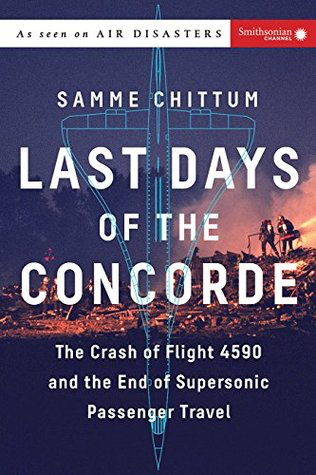Last Days of the Concorde: The Crash of Flight 4590 and the End of Supersonic Passenger Travel by Samme Chittum

My Rating of “Last Days of the Concorde: The Crash of Flight 4590 and the End of Supersonic Passenger Travel” by Samme Chittum: 9 / 10

It has been nearly 20 years since Flight 4590 had its fatal accident after taking off from Charles de Gaulle. I remember that day and the impact it had on the industry. It had ripple effects on the future of supersonic flight and airline innovation. Last Days of the Concorde was released only last year and since then I’ve had this on my list to read!
It was an excellent read and well put together. It profiled all the key people involved, each step of the journey; prior, during and and post the accident. The reader gets to understand about Concorde, supersonic technology, crash investigations all things air traffic control.
What I really liked about this book was all the facts, figures and stories about Concorde and its capability. It is such a shame it had to stop flying in 2003. After nearly two decades it isn’t a surprise it doesn’t fly given the small passenger capacity coupled with a high consumption of fuel. The world’s focus on climate change would never allow a plane like Concorde to continue flying today. With that said, my prediction is that supersonic flight will raise its head again in the future.
Three key takeaways from the book:
- It took one tonne of fuel for each passenger on the Concorde flight to get across the Atlantic. It is an incredible amount of fuel compared with subsonic flight! Said differently, it took 4.3 US Gallons for the Concorde to travel just 1 kilometre (0.62 miles). Heck, it took one tonne of fuel to taxi to the runway! However at an average cost of $12,000 per ticket at the time it was just profitable.
- Only 20 Concordes had ever been built, including prototypes and preproduction models, and just 14 were destined to enter commercial service for British Airways and Air France; each airline purchased seven Concordes. In 2000, only six of the original seven Air France Concordes were being actively flown after the airline retired one in 1982 to be used as a ready source of spare parts for the remaining six. Concorde’s safety record was enviable: Not a single life had been lost in a crash in its 24 years of commercial service, inaugurated with regularly scheduled flights that began in 1976.
- The only customers were British Airways and Air France. In July 1972, British Airways bought five Concordes, valued at £164 million, for the bargain price of £13.2 million per aircraft (for a total of $66.3 million); another two were essentially given away to British Airways for the token sum of £1 apiece. Air France signed a contract at the same time to buy four Concordes at the same price, followed by individual sales of three more planes over the next eight years. Concorde F-BTSC, for instance, was leased to Air France in 1976 for daily flights until other aircraft were delivered. It was returned to Aérospatiale later that same year and placed in storage. Air France leased it once more in 1979 before it at last purchased the plane for one franc in October 1980.




